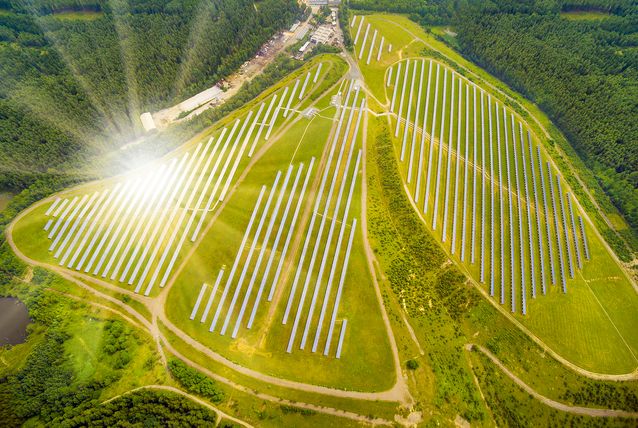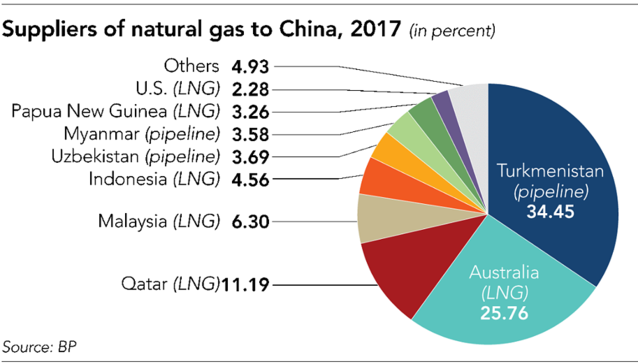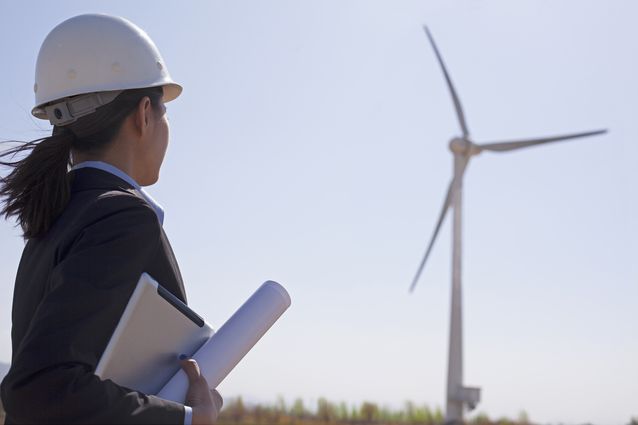
China is taking a big step forward now that it has radically changed its energy policy. Having become the largest user of coal in the world, it is now trying to shift its focus to gas and renewable energy sources. This offers an enormous opportunity to commercialise novel energy technologies that have been missing in the market.
Try to take a selfie in the Forbidden City in Beijing – it should now look very impressive. Your chances of getting a bright blue sky in the background and beautiful sunlight in the photo are higher than they have been for many years.

The Chinese Government is making an impressing change to its energy policy. You can see the results in the sky of China’s capital city. A Greenpeace analysis of government data found that pollution levels in Beijing dropped by half in the last three months of 2017 compared to a year earlier. [1]
This year, progress has remained good. The US Embassy in Beijing gathers data on monthly pollution readings. Of the seven lowest monthly pollution readings in the capital city since 2008, five have been recorded since the beginning of last summer. [2]
Even though some of the most polluted cities of the world are still in China, there is now considerable evidence of positive development even outside of Beijing. Pollution in 28 cities in north-eastern China has fallen sharply. It has been dropping 33% on average compared with the last three months of 2016.
China is the world’s largest energy consumer
Making a change like this in China is not a small project. China is the largest energy consumer in the world, with a primary energy consumption of 35 500 TWh in 2016 [3]. It consumes 25% of the energy used globally every year. [4]
Generating all that power has been done through very dirty means. Two thirds of the power have been produced by burning coal. China produces and uses more than half of all the coal burnt in the whole world.

The growth of coal use has been rapid. China now uses almost 3 billion tonnes of coal every year. In 1990, it used less than 0.5 billion tonnes of coal annually. Today, China is already consuming more than half of all the burned coal in the world. [5]
In addition to the significant problems with air quality and smog, this means China nowadays emits more CO2 than any other nation. Even though China’s CO2 emissions per capita are, for example, only half of the emissions of Canada and less than half of the emissions of the USA [6], China emits more carbon dioxide than the US and EU combined [7]. It is responsible for some 30% of all fossil fuel CO2 emissions in the world [8].
Finding the solution by diversifying the energy mix

To make this change, China is increasingly diversifying its energy mix. One of the greatest measures in its energy revolution is the rapid transition to gas. There is a strong political effort to transform coal-fired power plants into gas for the industrial and domestic sectors. The share of gas in China’s primary energy mix is set to rise from under 6% to over 12% by 2040 and at the same time the total power generation will double [9]. In other words, in 2017 China was already the third biggest consumer of natural gas in the world, with 6.6% of total consumption, and it is set to grow this usage by a factor of four in just 20 years. [10]
Natural gas demand will rise to over 600 billion cubic metres (bcm) by 2040. It will make China the second-largest market globally behind the United States and the largest source of global gas demand growth. [11]
China imports gas in two ways: as LNG and through pipelines. China imported 38.13 million tons of LNG in 2017, up 46% from 2016. The trend is continuing; in 2018, Chinese LNG terminals received record amounts of LNG [12]. China's LNG imports have tripled in just six years. If we include gas supplied by pipeline, China is now surpassing Japan as the world’s top importer of gas. [13]

Rapid rise in the use of solar and wind energy
China also invests heavily in renewable energy sources. Since 2012, total installed solar photovoltaic generation has increased from less than 10 gigawatts to about 130 gigawatts, marked by a 50-gigawatt increase from 2016 to 2017.
At the same time, installed wind capacity in China has grown from just over 60 gigawatts to slightly more than 160 GW [14]. More than one third of total wind power capacity of the world is now in China. Already in 2015, China was installing more new wind power capacity than the whole of the European Union. [15]
In addition, strong deployment and policy support continue to bring costs down for renewables. According to the International Energy Agency (IEA), solar photovoltaic (PV) will become China’s cheapest form of electricity generation. Average solar PV projects in China have become cheaper than both new and existing gas-fired power plants around 2020 and cheaper than new coal-fired capacity and onshore wind by 2030. [16] As I wrote in my previous article, this will inevitably mean that large investments in supplemental power generation are required due to fluctuating power generation from renewables. [17]
China is also increasing the direct use of renewables in end-use sectors. It will do this through bioenergy in industry, solar thermal for heating and biofuels for transport. By 2040, electricity will become the leading source of final energy consumption in China, overtaking coal in the late 2020s, and oil shortly thereafter. [18]

Way to go with energy efficiency
One important tool for the government to achieve its goal is by increasing energy efficiency. In general, China has had problems with low efficiency in its industrial production. Apart from how it feeds its economic growth, China has consumed a large amount of raw materials to generate the same wealth as other countries such as Japan, Germany or the United Kingdom; between 200 – 300% more. [19] However, this is also changing; for example, in 2016 China initiated a G20 Energy Efficiency Leading Programme which prioritises energy efficiency even above renewables.
China is about to reduce the pace of growth in energy demand to around 1% per year, less than one-sixth the average that the country has experienced each year since 2000. This will be done by executing new strong energy efficiency policies. More than half of the national energy consumption is already covered by mandatory energy efficiency policies. [20]
It is also being supported by structural shifts in the economy and demographic changes. The total energy demand growth to 2040 should roughly be at the same level as China experienced in the eight years between 2008 and 2016. [21]
Since the economy continues to grow rapidly, at an average rate of 4.5% per year, this equates to an improvement of 3.4% per year in energy intensity, the fastest rate of improvement seen worldwide in the IEA’s projections to 2040. However, at the same time, per-capita energy consumption is also growing, by one-quarter through to 2040, overtaking that of the European Union by around 2035. [22]
China already has a positive record in this field. If China hadn’t made the energy efficiency improvements it has since 2000, it would have used 12% more energy in 2017. The efficiency improvements in China’s industry service sectors and residential sector until 2017 has equalled the total energy consumption of Germany. [23]
Burning coal will not stop
It is certainly true that we must take all these positive steps with a pinch of salt. New steps are important but growing demand for energy is limiting their impact. New energy plants are likely to produce energy in a much cleaner way than before, but the old ones keep on running. The number of Chinese coal plant retirements remains relatively low. Since 2014, about 25 gigawatts of coal-fired capacity has been retired. By comparison, almost 50 gigawatts have been retired in the U.S. over the same period, though the amount of coal capacity in the US is only a third of China’s. [24]

China must also invest heavily in grids before we can talk about a full revolution having taken place. Already today, some 15% of China’s wind and solar PV generation is being curtailed because it cannot be accommodated by the existing power system. New power transmission lines are needed to enable China’s inland renewable potential to bring cheaper power to demand centres closer to the coast. [25]
China is also lacking capacity. Although the Chinese government is determined to develop, for instance, the decentralized gas power generation market, it seems like the lack of technological capacity – especially low-emissions solutions – has impeded its development.
Increased opportunities to develop new technology
China’s energy revolution has several positive impacts for the world. In addition to reducing harmful emissions in China, it is speeding up positive technological development across the globe.
We are already seeing this with solar panels. One key reason for the rapid development of the panels and the lowering of prices is the mass production built for the Chinese markets.
I assume we will see positive development with biogas, as well. Biogas is an environmentally friendly source of energy. However, its use requires more adjustments than the use of natural gas. Biogas is a true product of nature: its methane content is lower than natural gas and the mix of gases in it varies. When China needs to find more and different kind of energy sources, we will see major investments in this field, because China needs to make use of all alternatives to coal.
Due to the present pollution problems, China urgently wants to lower its NOx emissions. NOx is one of the key reasons that causes smog to cover the sky and health problems in our lungs. As part of the solution, China wants to increase the use of gas turbines even in small scale solutions of under 1 MW. It is now investing heavily in research and development in this field [26]. Microgrids based on less polluting energy sources will be an essential part of the solution for such a huge country with large distances between energy resources and consumers – and solutions in this field are certainly needed all around the world.
-------------------------------------------------------------------------------------
- https://www.nytimes.com/2018/01/11/world/asia/pollution-beijing-declines.html
- https://www.bloomberg.com/news/articles/2018-08-19/xi-s-clean-energy-drive-paints-bluest-sky-over-beijing-in-decade
- https://www.bp.com/content/dam/bp/en/corporate/pdf/energy-economics/energy-outlook/bp-energy-outlook-2018-country-insight-china.pdf
- https://www.ft.com/content/0094d3c3-405b-3966-a088-1060fa2cdc2e
- BP: BP Statistical Review of World Energy. June 2018.
- https://data.worldbank.org/indicator/EN.ATM.CO2E.PC
- https://www.forbes.com/sites/rrapier/2018/07/01/china-emits-more-carbon-dioxide-than-the-u-s-and-eu-combined/#3429afea628c
- http://edgar.jrc.ec.europa.eu/booklet2017/CO2_and_GHG_emissions_of_all_world_countries_booklet_online.pdf
- https://www.iea.org/weo/china/
- BP: BP Statistical Review of World Energy. June 2018.
- https://www.magnuscmd.com/the-change-in-energy-policy-in-china-gas-for-coal/
- https://www.enerdata.net/publications/daily-energy-news/chinese-lng-terminals-received-record-amounts-lng-2018.html?utm_source=Enerdata&utm_campaign=24a74683ed-Email_Daily_Energy_News_01_2019&utm_medium=email&utm_term=0_838b1c9d18-24a74683ed-124325949
- https://asia.nikkei.com/Business/Markets/Commodities/China-on-pace-to-become-top-natural-gas-importer-in-2018
- http://ieefa.org/ieefa-china-a-sea-change-in-energy-policy/
- https://www.evwind.es/2016/06/23/8-countries-that-produce-the-most-wind-energy-in-the-world/56665
- https://www.iea.org/weo/china/
- https://www.linkedin.com/pulse/renewable-energy-only-clean-power-generation-supports-matti-malkam%C3%A4ki/
- https://www.iea.org/weo/china/
- https://www.magnuscmd.com/the-change-in-energy-policy-in-china-gas-for-coal/
- Zheng et al., Energy Policy Volume 122, November 2018, Pages 580-591.
- https://www.iea.org/weo/china/
- https://www.iea.org/weo/china/
- IEA Energy Efficiency 2018 report
- http://ieefa.org/ieefa-china-a-sea-change-in-energy-policy/
- https://www.iea.org/weo/china/
- National Energy Administration, Energy Technology Innovation "13th Five-Year Plan"
